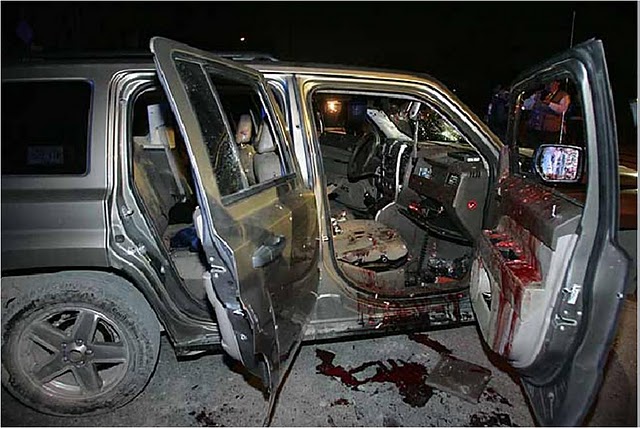
On September 16, 2008, Carl Pike, the deputy head of the Drug Enforcement Administration’s Special Operations Division, watched live video feeds from a command center outside Washington, D.C., as federal agents fanned out across dozens of U.S. cities. In Dallas, a team in SWAT gear tossed a flash-bang grenade into a suburban home and, once inside, discovered six pounds of cocaine behind a stove, and a stockpile of guns. At a used-car dealer’s house in Carmel, Indiana, agents pulled bricks of cocaine from a secret compartment in his Audi sedan, while state troopers dragged a stove-size safe onto the lawn and went at it with a sledgehammer.
In the coming weeks, the net widened to include caches of assault rifles, a Mexico-bound 18-wheeler with drug money hidden in fresh produce, and a crooked Texas sheriff who helped traffic narcotics through his county. In Mexico City, a financier was arrested for laundering drug money through a minor-league soccer team named the Raccoons (and an avocado farm). After one especially large bust, when it came time for a “dope on the table” photo, there was in fact no table big enough to support the thousands of tightly bundled kilos of confiscated cocaine. They had to be stacked in the back parking lot of a police station.
The raids and arrests were the final stage of a DEA-led investigation called Project Reckoning—18 months, 64 cities, 200 agencies—intended to cripple Mexico’s Gulf Cartel. Over the past two decades, the organization had built a drug empire that spanned across Mexico and into the U.S. It had become pervasive, hyper-violent, brazen. Cartel operatives had smuggled billions of dollars’ worth of narcotics into the U.S.
 They had assassinated Mexican politicians and corrupted entire police departments. One of the organization’s leaders had famously brandished a gold-plated .45 at two agents from the DEA and FBI traveling through northeastern Mexico. The cartel had even formed its own paramilitary unit, a band of former Mexican police and special-forces soldiers called the Zetas, to seize territory and dispatch rivals. The notorious syndicate became known as La Compañia, or The Company.
They had assassinated Mexican politicians and corrupted entire police departments. One of the organization’s leaders had famously brandished a gold-plated .45 at two agents from the DEA and FBI traveling through northeastern Mexico. The cartel had even formed its own paramilitary unit, a band of former Mexican police and special-forces soldiers called the Zetas, to seize territory and dispatch rivals. The notorious syndicate became known as La Compañia, or The Company.
Project Reckoning, authorities proclaimed, had dealt La Compañia’s business a “substantial blow.” The DEA’s Pike likened it to taking out 64 cartel-owned Walmarts. And once all the doors had been kicked in, the haul was indeed staggering: $90 million in cash, 61 tons of narcotics, and enough weapons to equip an insurgency. Among the 900 people rounded up across the U.S. and Mexico, the Justice Department indicted dealers, transporters, money counters, teen gangsters, and even the owner of a Quiznos franchise. One of those swept up in the net was a 37-year-old resident of McAllen, Texas, named Jose Luis Del Toro Estrada.
He seemed, at first, not particularly significant—a luckless guppy caught swimming with sharks. His arrest barely warranted mention in the local paper. His house, a well-maintained white-brick rancher with an arbor of pink flowers over the front door, contained no cocaine or caches of AK-47s. He lacked an extensive rap sheet and in fact seemed to have no criminal record at all. On the outskirts of McAllen, he ran a small, nondescript shop that installed car alarms and sold two-way radios. (for best viewing, enlarge to full size Del Toro’s Plea Agreement-then adjust size to preference) Jose Luis Del Toro Estrada Plea Agreement contains information regarding the communication system In the weeks that followed, a different picture began to emerge. Del Toro Estrada was neither capo nor killer, but he played a critical role in The Company. According to federal prosecutors, the shop owner—who went by the alias Tecnico—had served as The Company’s communications expert. He was the cartel’s in-house geek, the head of IT, and he had used his expertise to help engineer its brutal rise to power. Del Toro Estrada had not only set up secret camera networks to spy on Mexican officials and surveil drug stash houses, but he also built from the ground up an elaborate, covert communications network that covered much of the country.

This system enabled the cartel to smuggle narcotics by the ton into the U.S., as well as billions of dollars in drug money back into Mexico. Most remarkably, it had provided The Company with a Gorgon-like omniscience or, according to Pike, the ability to track everything related to its narcotics distribution: drug loads but also Mexican police, military, even U.S. border-patrol agents. That a cartel had begun employing communications experts was likely news to most of law enforcement. That it had pulled off a massive engineering project spanning most of Mexico—and done so largely in secret—was unparalleled in the annals of criminal enterprise.
The godfather of the Gulf Cartel was not a drug kingpin but a contrabandista named Juan Guerra who began smuggling bootleg whiskey into Texas during Prohibition. In the decades that followed, Guerra expanded into prostitution and gambling along the Rio Grande, building out a small but profitable criminal enterprise. The business eventually passed to Guerra’s nephew, Juan Garcia Abrego, who in the mid-1980s identified an opportunity. Several years before, American drug agents had started to crack down on cocaine-supply lines from Colombia into Florida.
 Garcia Abrego approached the besieged Colombians with an offer: Instead of taking a transporter’s customary small cash percentage, he would guarantee cocaine deliveries through Mexico into the U.S. in exchange for 50 percent of each load. It was a riskier but immensely more profitable arrangement, and it eventually birthed one of Mexico’s first major narcotics organizations, the Gulf Cartel. In 1995, the FBI placed Garcia Abrego on its Ten Most Wanted list, the first drug trafficker to earn the distinction.
Garcia Abrego approached the besieged Colombians with an offer: Instead of taking a transporter’s customary small cash percentage, he would guarantee cocaine deliveries through Mexico into the U.S. in exchange for 50 percent of each load. It was a riskier but immensely more profitable arrangement, and it eventually birthed one of Mexico’s first major narcotics organizations, the Gulf Cartel. In 1995, the FBI placed Garcia Abrego on its Ten Most Wanted list, the first drug trafficker to earn the distinction.
Garcia Abrego led the cartel until 1996, when he was arrested by Mexican police outside the city of Monterrey. His successor was a jug-eared, mercurial former auto mechanic and aspiring gangster named Osiel Cardenas Guillen, a.k.a. The Friend Killer. In the late 1990s, hoping to surround himself with an impenetrable security ring while also creating a lethal mercenary force, Cardenas Guillen formed a paramilitary unit composed largely of defectors from the Mexican police and military.
Some, like Heriberto Lazcano Lazcano, a.k.a. The Executioner, were commandos from an elite American-trained airborne special-forces unit. It was an epochal moment in cartel development. The Zetas—who reportedly took the name from their first commander’s military radio call sign, Z1—were highly trained and brutally efficient. They built remote narco-camps to train new recruits in military tactics, weapons, and communications. They recruited other special-forces soldiers from Guatemala, known as Kaibiles, a name derived from an indigenous leader who bedeviled Spanish conquistadores in the 16th century.
They secured new drug routes, attacked other gangs, and even instituted an accounting system—the Zetas kept detailed ledgers and employed a dedicated team of number crunchers—that has since become nearly as legendary as the group’s capacity for bloodletting. “Before the Zetas, it was basically low-quality foot soldiers and enforcer types,” says Robert Bunker, a visiting professor at the U.S. Army War College’s Strategic Studies Institute. “What the Zetas brought to the table was that [military] operational capability. The other cartels didn’t know anything about this. It revolutionized the whole landscape.” It’s impossible to say exactly why the Zetas chose to build the radio network, but given their military and law-enforcement background, it seems likely that Z1 and his capos understood that a widespread communications system would provide a crucial competitive edge over other cartels. Radio was the clear choice. Unlike cell phones, which are expensive, traceable, and easily tapped, radio equipment is cheap, easy to set up, and more secure. Handheld walkie-talkies, antennas, and signal repeaters to boost transmissions are all available at a good radio shop or from a Motorola distributor. A radio network could provide communications in many of the remote areas in Mexico where the cartel operated. And, if they suspected law enforcement eavesdropping, the cartel’s drug smugglers and gunmen could easily switch frequencies or use commercially available software to garble voice transmissions.
How Jose Luis Del Toro Estrada was tapped to develop the covert radio network also remains a mystery, but as his system grew, it supplied the Zetas with what’s called a command-and-control capacity. “It essentially linked all the different members of the cartel—the people doing the trafficking and the people doing the protection—so there was a communication between them,” says Pike, the DEA special agent.
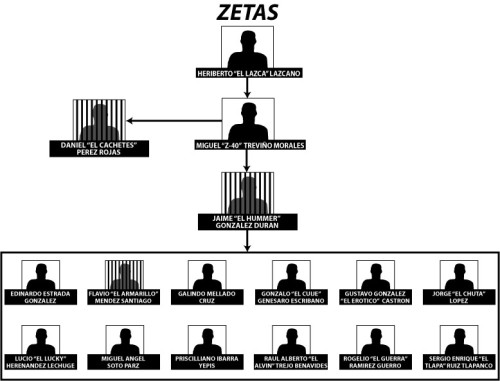
Armed with handheld radios, the cartel’s street-corner halcones, or hawks, could help commanders avoid arrest by alerting them whenever police set up checkpoints. A midlevel boss in Nuevo Laredo could monitor a semitruck carrying several tons of cocaine as it trundled across the border into Texas. Most crucially, Zetas gunmen could use the system to attack and seize plazas, or smuggling corridors, held by other drug gangs.
“With a network like this, you can take what resources you have and maximize them for effectiveness,” says Bunker. “If [the Zetas] are going into a different cartel’s area, they can bring resources in,” such as weapons, vehicles, and reinforcements. “It means for every one enforcer or foot soldier, you get a multiplier effect. From a command-and-control perspective, it’s phenomenal.” With the advantage of Del Toro Estrada’s radio network, The Company grew quickly, dominating rival groups—but lasting relationships are fleeting in the criminal underworld. In 2010, after several years of internal friction, the Gulf Cartel and the Zetas severed ties. (Causes of the split are murky, but many analysts say the breaking point occurred when the Gulf Cartel kidnapped and killed the Zetas’ chief of finance after failing to persuade him to switch allegiance.) In the years that followed, the influence of the Gulf Cartel, once the most powerful in Mexico, waned dramatically. At the same time, the influence of the Zetas grew rapidly. Their business portfolio expanded to include drug running as well as kidnapping, human smuggling, pirating DVDs, and even selling black-market oil. In some regions, they began to operate with such impunity that their authority eclipsed that of the Mexican government itself. The Zetas’ military training and ultraviolent tactics were crucial for propelling their rise to power, but one other factor was essential: After splitting from the Gulf Cartel, it was the Zetas who maintained control of the radio network.
 After Project Reckoning, Del Toro Estrada became a ghost. Neither the DEA nor the Justice Department would discuss his case. Letters to the Reeves County Detention Complex in West Texas, where he was housed for a time, remain unanswered. Before his arrest, though, Del Toro Estrada had lived openly in Texas for at least a decade as a resident alien with a green card. He ran a small radio shop called V & V Communications that sold walkie-talkies and other equipment. He and his wife owned several modest properties around McAllen, including a nicely wooded ranchito with a small horse stable and a swimming pool. An American flag hung from the front porch.
After Project Reckoning, Del Toro Estrada became a ghost. Neither the DEA nor the Justice Department would discuss his case. Letters to the Reeves County Detention Complex in West Texas, where he was housed for a time, remain unanswered. Before his arrest, though, Del Toro Estrada had lived openly in Texas for at least a decade as a resident alien with a green card. He ran a small radio shop called V & V Communications that sold walkie-talkies and other equipment. He and his wife owned several modest properties around McAllen, including a nicely wooded ranchito with a small horse stable and a swimming pool. An American flag hung from the front porch.
Many details about Del Toro Estrada’s involvement with The Company remain opaque. It’s unclear whether he was recruited in McAllen or placed there as an operative. Also unclear is whether he was a formally trained engineer or some kind of criminal autodidact who spent years steeping himself in the finer points of radio-broadcast engineering. Either way, he did not match the profile of a typical cartel member. “He wasn’t an assassin. He was a geek, a technician,” says a former federal counter-narcotics official who now runs an intelligence consulting firm in Arlington Virginia.
Yet a technically savvy radio operator living near the U.S. border was precisely what the Zetas required. According to the former official, the Zetas first began building the radio network in Matamoros, a border city across from Brownsville, Texas, around 2004. Del Toro Estrada probably served as the project’s overseer. Initially, the small cluster of radios and antennas were tools to monitor police and other drug gangs. But then-president Felipe Calderón deployed troops and tightened security around air and sea routes into Mexico.
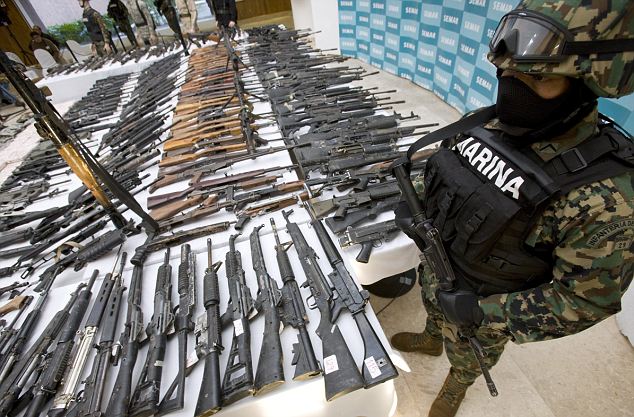
With its ports of entry blocked, the cartel looked south and began establishing a strong presence in Guatemala. The country’s 600 miles of remote, porous border abutting Mexico made it an ideal overland entry point for narcotics. Drug runners could land multiton cocaine loads from Colombia at remote jungle airstrips in northern Guatemala and truck them across the border; at least 125 road entries allow vehicles to pass without inspection. From there, they would drive loads north to busy U.S. ports such as El Paso. The route was costly and logistically complex, so around 2006, the Zetas began expanding the radio network to help manage it: first along the Texas border, then down the Gulf Coast to Guatemala, and eventually into Mexico’s interior.
In any new city where the cartel wished to expand, Del Toro Estrada’s first step would have been to map the local radio spectrum. Identifying who operated on what frequencies and which had the lightest traffic would preclude, for example, a local taxi company’s radio chatter from disrupting a coordinated attack on a police station. In urban areas, Del Toro Estrada often affixed a cartel antenna to an existing commercial radio tower. He also hijacked radio repeaters—devices that receive and boost radio signals—from companies like Nextel and reprogrammed the equipment to use the cartel’s preselected, low-volume frequencies. (Nextel maintains both cellular and, for its push-to-talk phones, radio networks). In at least one location, Del Toro Estrada installed a repeater on the roof of a Mexican police station, either a brazen display of the cartel’s impunity or a signal of the department’s corruption.
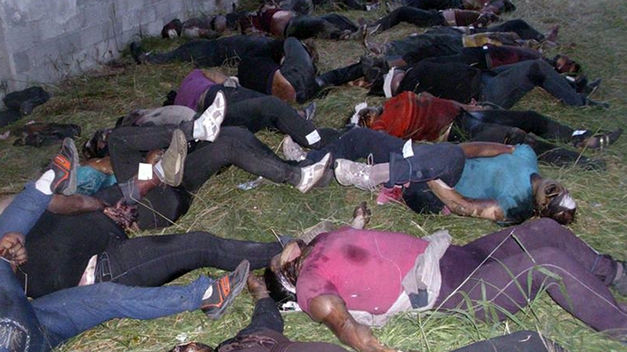
Expanding into more remote areas, like the jungle in southern Veracruz state, was more technically challenging: Towers had to be built atop high vantage points—a volcano’s summit, for example—to ensure surrounding hills or other natural obstacles didn’t block transmissions. Del Toro Estrada then installed repeaters and antennas on top of the tower, and in some instances, the structure was painted a dark green to camouflage it amid the foliage. To provide power, he wired the equipment to car batteries or, in many cases, photovoltaic solar panels. In Veracruz, a string of about a dozen tower installations provided a 100-mile radius of communications capability—meaning the Zetas could track anything that moved, whether encroaching Sinaloa cartel gunmen or military convoys, in at least 10 towns and cities.
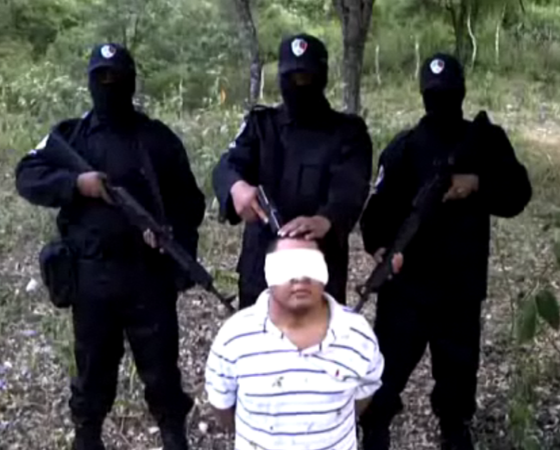
“It was just a constant flow of information,” Pike says. “I equate it to the scene in Black Hawk Down when the chopper’s taking off from the military base and the child up on the mountain with the telephone calls down and says, ‘They’re coming.’
As subnetworks went live in new areas, Del Toro Estrada daisy-chained them together into a larger, interoperable system. This ability to link different units of the cartel was the network’s strength, more than anything else. With commercial software from companies like Motorola, he could remotely manage thousands of walkie-talkies at one time. If a frequency in one area became too congested, he could switch users’ radios to another.
If a local boss in Matamoros had to coordinate a drug load with someone in Monterrey, Del Toro Estrada could connect them. If Zetas were captured, he could disable their handsets to thwart eavesdroppers. He also used digital inversion software, which scrambles radio transmissions into garbled, R2-D2–like squawking. The cartel even established regional command centers to manage some of its communications. In Coahuila state, Mexican soldiers raided a Zetas-occupied home that contained networked laptops, 63 digital walkie-talkies, a central processing unit to remotely control repeaters, and a digital radio that communicated with airplanes.
By 2008, Del Toro Estrada’s infrastructure was operational in most states in Mexico (and likely in the U.S. borderlands as well). Local bosses chipped in for equipment, and the Zetas maintained ledgers detailing outlays for communications gear. Del Toro Estrada himself employed a team of specialists—his own cartel Geek Squad—to research new technology and program equipment. The network’s architecture, like the nodes of routers that undergird the Internet, was resilient: If the Mexican military knocked out one tower, traffic could likely be routed through another. And it was, relatively speaking, cheap: The Company probably spent tens of millions of dollars building the network—a capital investment that would have paid for itself with the delivery of one large cocaine shipment into the U.S.
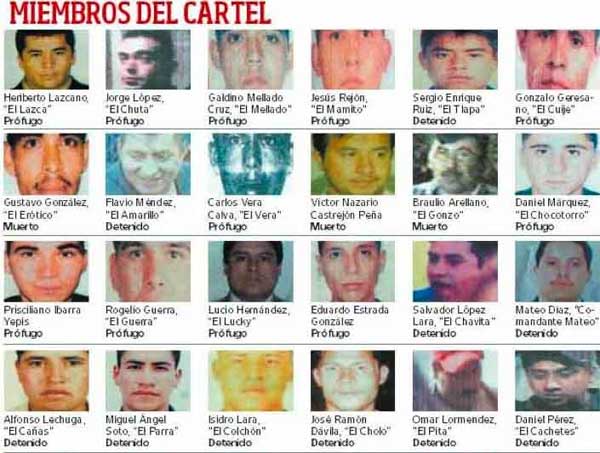
“This thing was huge,” the former official says of the cartel’s communications system. “It was extensive, and it was interconnected. It was the most sophisticated radio network we’d ever encountered.”
To manage a system of this size, Del Toro Estrada likely required a base of operations. His McAllen radio shop, V & V Communications, could have been an ideal location. It was unremarkable, close to the border, and, with radios purportedly for sale to the buying public, it provided a veneer of legitimacy.
The building—a white, single-story box with mirrored windows—still sits on a barely trafficked side street on the outskirts of the city. A 30-foot antenna tower juts from the roof. Customers must buzz in through the locked front entrance. A surveillance camera monitors the door; two more cover the store’s interior. Inside, there are no handheld radios on display, no repeaters, no cables or chargers—no inventory at all, save for a few aged and disused radio-equipment pamphlets in a dusty glass case. The woman working the counter speaks only Spanish, and she seems neither prepared nor pleased to have visitors. On her business card is a nonworking email address and a website that does not exist.
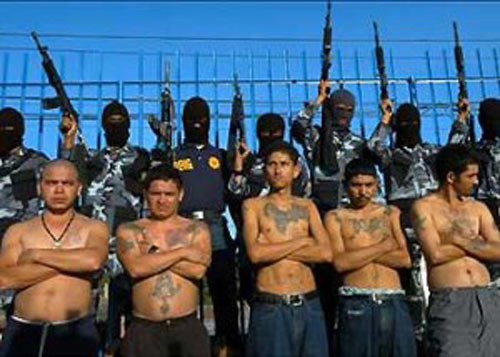 American officials have not publicly discussed the Zetas’ radio network, but it’s obvious there’s an inverse relationship between it and the stability of the Mexican state. The larger the network grew, the more imperiled the state became. The flow of drugs north enabled a flow of cash south, which the cartel could use to buy off police, politicians, and public officials, as well as to hire new recruits and purchase guns—lots of guns. In 2008, soldiers raided a Company stash house containing the largest weapons cache seized in Mexican history: 500 handguns and assault rifles, a half-million rounds of ammunition, 150 grenades, seven .50-caliber sniper rifles, an anti-tank rocket, and 14 sticks of dynamite.
American officials have not publicly discussed the Zetas’ radio network, but it’s obvious there’s an inverse relationship between it and the stability of the Mexican state. The larger the network grew, the more imperiled the state became. The flow of drugs north enabled a flow of cash south, which the cartel could use to buy off police, politicians, and public officials, as well as to hire new recruits and purchase guns—lots of guns. In 2008, soldiers raided a Company stash house containing the largest weapons cache seized in Mexican history: 500 handguns and assault rifles, a half-million rounds of ammunition, 150 grenades, seven .50-caliber sniper rifles, an anti-tank rocket, and 14 sticks of dynamite.
In recent years, the specter of midday combat in Tamaulipas, where the Zetas were battling their former employers for control, has grown increasingly common. In 2010, Zetas gunmen kidnapped and executed 72 Central American migrants, perhaps because they feared the Gulf Cartel might have hidden newly recruited assassins among them.
That July, a heavily armed contingent of Zetas in Nuevo Laredo used an elaborate system of narco-blockades, or stolen trucks and buses parked in intersections, to funnel rivals into deadly ambushes. After a running, midday shootout that lasted hours, authorities recovered among the assault rifles and dead bodies a number of walkie-talkies—a sign, very likely, of Del Toro Estrada’s handiwork. The governor of Tamaulipas soon declared the region “ungovernable.”

With the Zetas at the center of the violence, the Mexican military decided to strike back at their most valuable asset: the radio network. Battalions of troops were dispatched, and the military began attacking the system, probably aided by DEA-supplied intelligence directly from Del Toro Estrada, who began cooperating with the agency after his arrest and provided information about the system’s infrastructure. During one operation in 2011, Mexican marines discovered several 18-wheelers housing mobile communications systems in Veracruz. Another operation spanned four states and resulted in an astonishing haul: 167 antennas, 155 repeaters, 71 computers, 166 solar panels and batteries, and nearly 3,000 radios and Nextel push-to-talk phones. Later, marines discovered a 300-foot-tall antenna tower by a major highway.
After the raids, masked soldiers posed with enough seized equipment to supply several Radio Shacks, while a military spokesman announced the disruption of the Zetas’ “chain of command and tactical coordination.” This was perhaps true, but the cartel also simply reinstalled towers and antennas once the military pulled out. It’s also possible that the organization had conscripted a skilled, though unwilling, workforce to keep its radio network functioning after Del Toro Estrada’s arrest.
Since 2009, reports have surfaced of communications specialists and engineers disappearing across the country. In one of the first known cases, nine Nextel technicians were kidnapped from a hotel in Nuevo Laredo. The men had planned to work in the area for several months expanding the company’s spotty radio coverage, said Amalia Armenta, the wife of one of the victims. On June 20, she says, they were taken in the middle of the night by armed gunmen. None of them has been located. At least 27 other engineers and specialists from companies like IBM, ICA Fluor Daniel, and Mexico’s state-run oil company Pemex have also since disappeared. Even without their chief radio architect, the Zetas were not going to give up one of their prized assets easily.
By 2011, Del Toro Estrada was being held in the federal detention center in Houston, a hulking granite edifice in the city’s downtown that houses about 1,000 inmates. Most await trials or sentencing in the federal district court several blocks away. On May 11, Del Toro Estrada appeared before a federal judge for a final sentencing hearing, and then on June 21, 2012, after serving less than four years for having built one of most elaborate criminal infrastructure projects in history, he walked out of the prison’s grim sprawl into the bright Texas sun.

He had pleaded guilty to one charge of conspiracy to distribute cocaine, but while in custody, the prosecutors had offered to seek a lighter sentence in exchange for information about his former employers. Acting as a snitch would have made him a marked man, so following release, Del Toro Estrada may have disappeared into witness protection. He also may have fled back to Mexico, although this would have almost certainly made him more vulnerable to the cartel’s reach. Or, perhaps he and his wife decided to hide in plain view. Four months after his release, the couple’s white-brick rancher in McAllen still appeared occupied.
It’s also plausible that the Zetas, increasingly under pressure by both rival cartels and the Mexican government, had been forced to concentrate on bigger problems. In July 2011, Mexican authorities arrested a top Zetas commander named El Mamito and soon nabbed another, who called himself El Taliban. A year later, soldiers stumbled upon the Zetas’ top commander, Heriberto Lazcano Lazcano, at a small-town pickup-baseball game in Coahuila state. After a gunfight, they shot and killed him, along with two bodyguards. He was, by most estimates, the most high-profile narco to fall in the drug war, and the government proudly trumpeted his death as an important victory—one that dimmed somewhat after a contingent of gunmen spirited his body from the funeral home just hours after his death. In mid-July 2013, his successor, Miguel Angel Treviño Morales, was arrested in Tamaulipas, reportedly with assistance from U.S. intelligence.
The arrests were deeply symbolic—tangible signs of progress against the cartel. In reality, though, they just masked a much deeper problem. Del Toro Estrada’s radio network was only the first step in the Zetas’ information war. At the height of its power, the group developed a Stasi-like army of spies and integrated technology and social media into their operations. The result, according to a report from the Mexican attorney general, was an intelligence network “without equal in the Americas.”
The Zetas monitored Twitter feeds, blogs, and Facebook accounts. They reportedly employed a team of computer hackers to track authorities with mapping software, and, according to one paper, 20 communications specialists to intercept phone calls. On the street, the cartel’s informants included taxi drivers, taco vendors, shoe shiners—and often the police. In Veracruz, an entire department was dissolved after a commander was recorded ordering subordinates to serve as what the Mexican public, increasingly wary of its law enforcement, has come to call “polizetas.”
According to a woman in Tamaulipas who had been involved with a midlevel member of the Zetas, the cartel was also sufficiently organized to divide busy urban areas like Nuevo Laredo into sectors made up of about a dozen streets, with each sector containing some 20 halcones—meaning hundreds of vigilant sentinels deployed across a given neighborhood.
“They are usually hired for 10,000 pesos [about $750] and provided two cellphones and a radio,” she says. “They check who is walking down the street, and with whom. Usually it’s the police, the military, and other gang members. You can see them sometimes at each corner, depending on the zone, even in the outskirts near the highways. It extends all over the city.”
In just one location, a network of this size would generate hundreds if not thousands of texts, cellphone calls, and radio messages each day. Could a criminal organization be sophisticated enough to parse such a sea of data? Was there a roomful of bespectacled analysts somewhere, collecting and sifting through intelligence, then sending actionable leads up the chain of command? The answer, according to the former official familiar with Del Toro Estrada’s case, is essentially yes. In Nuevo Laredo, he says, the Zetas had so deeply infiltrated the city police force that they were able to use the department’s C4 office—Mexico’s version of 911—to control its information network.
With the loss of its top leadership, the Zetas’ power—just like that of its predecessor, the Gulf Cartel—seems to be waning. But profound success does not go unnoticed in any business, particularly one with billions of dollars at stake. The legacy of Del Toro Estrada’s radio network and the Zetas’ ruthless efficiency may have forever revolutionized the nature of cartel operations. In pioneering the use of new technologies and tactics—coordinated infantry-style attacks, hyperviolent “psy-ops” campaigns, sophisticated intelligence collection and communications—the Zetas created a new road map for criminal enterprise.
To remain competitive, other cartels have created their own paramilitary units, and the Sinaloa Federation, Mexico’s largest and most powerful drug-trafficking organization today, also reportedly has its own radio network. This is what some analysts have dubbed the “Zetanization” of Mexico. Cartel-deployed aerial drones and sophisticated data-mining software that tracks law-enforcement patterns and predicts ideal smuggling schedules and routes may not be far off. Such a nightmare scenario, if realized, will have started with humble beginnings: an anonymous shop owner armed with only a radio.
source
















